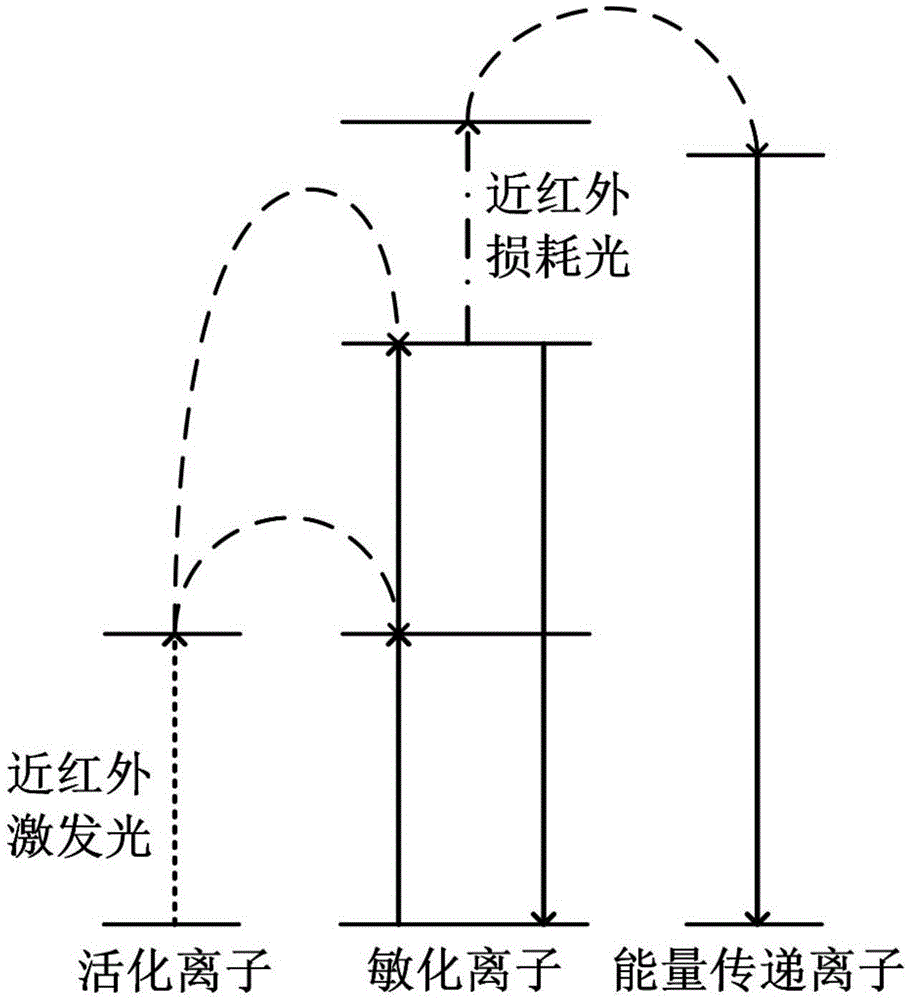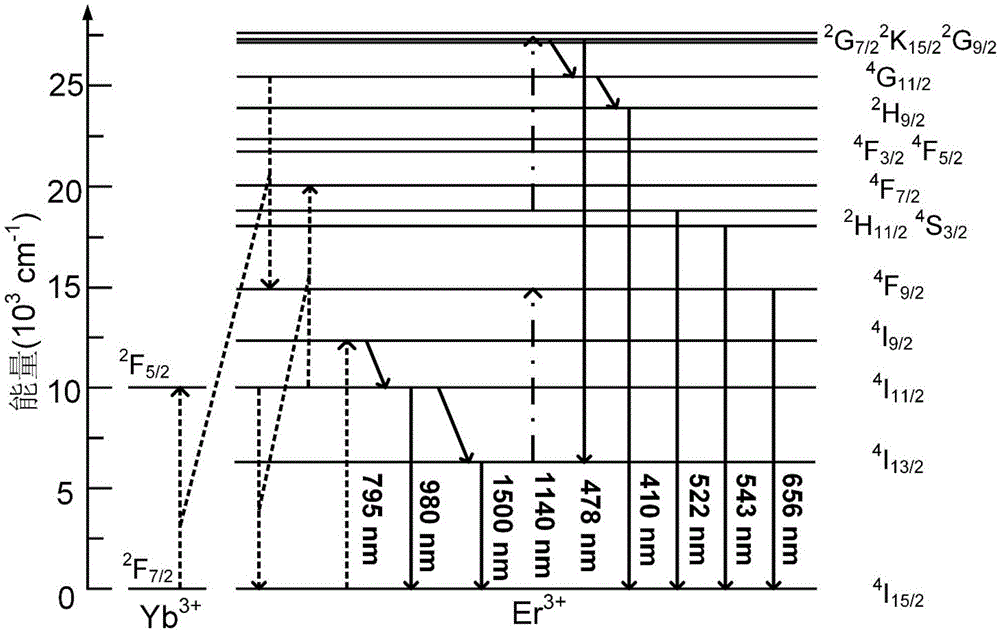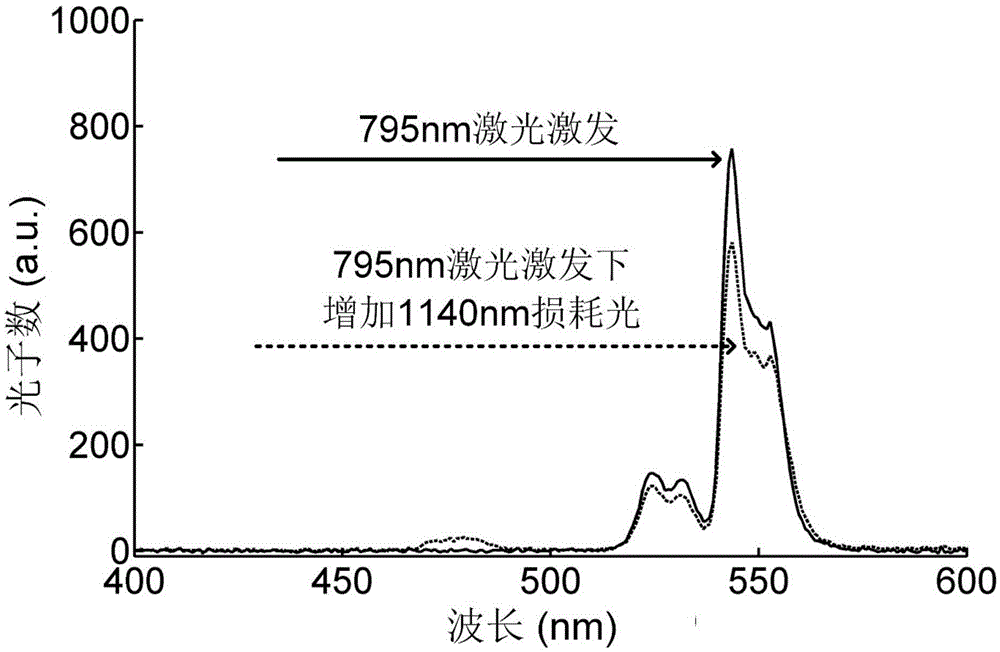Fluorescence depletion method and microscopic imaging method and device
A fluorescence loss, microscopic imaging technology, applied in the field of optical microscopy, can solve the problems of super-resolution imaging loss wavelength scattering, and achieve the effect of reducing complexity, low price, and good optical properties
- Summary
- Abstract
- Description
- Claims
- Application Information
AI Technical Summary
Problems solved by technology
Method used
Image
Examples
Embodiment 1
[0044] see figure 1 The wavelength bands of the near-infrared excitation light and the near-infrared depletion laser used in the fluorescence loss method in this embodiment are both between 760nm and 2000nm, and are used to excite rare earth-doped up-conversion nanomaterials. Rare earth ions in rare earth doped upconversion nanomaterials can be divided into three types according to their functions: activating ions, sensitizing ions and energy transfer ions. The steps are:
[0045] (1) Use near-infrared excitation light to excite rare earth-doped upconversion nanomaterials. After the activated ions absorb the near-infrared excitation light through ground state absorption, the energy is transferred to the sensitized ion through energy transfer upconversion and excited state absorption, and then The sensitized ions emit fluorescence in the ultraviolet, visible or near-infrared bands through the up-conversion process, that is, multi-photon fluorescence is excited.
[0046] (2) A...
Embodiment 2
[0052] Present embodiment except following feature other structures are with embodiment 1:
[0053] Such as Figure 5 shown, based on the upconversion NaYF 4 : Yb 3+ / Tb 3+ All two-photon fluorescence emitted under 980nm excitation (including 490nm, 546nm, 585nm, 620nm, etc.) can be consumed by another beam of near-infrared light (including 1108nm, 1264nm, 1374nm, 1541nm, etc.). In this example, Yb 3+ Acting as an activating ion, Tb 3+ As sensitizing ions and energy transfer ions.
[0054] The specific implementation process is as follows: under a certain power of 980nm laser excitation, two Yb 3+ After each ion absorbs a 980nm photon, a cooperative sensitization upconversion process (Cooperative Sensitization Upconversion, CSU) occurs, and it will be in the ground state 7 f 6 electrons excited to 5 D. 4 energy level. exist 5 D. 4 The electrons at the energy level will return to the corresponding low energy level by radiating fluorescence at 490nm, 546nm, 585nm, a...
Embodiment 3
[0056] Present embodiment except following feature other structures are with embodiment 1:
[0057] Based on the fluorescence loss method disclosed in Example 1, also based on up-conversion NaYF 4 : Yb 3+ / Er 3+ The green light emitted under 795nm excitation can be lost by 1140nm light. This embodiment provides a microscopic imaging method, the method comprising:
[0058] In the same way, a continuous laser with a wavelength of 795nm is used to emit a stable near-infrared wavelength laser as the excitation light. After the laser is filtered by a collimating beam expander and a small aperture diaphragm, a focused Gaussian solid spot is obtained;
[0059] At the same time, in the other path, a continuous laser with a wavelength of 1140nm is used to generate a stable near-infrared wavelength laser as a near-infrared loss laser. Modulate and form a hollow beam to obtain a stimulated emission depletion spot; the wavelength of the near-infrared depletion laser conforms to the 2...
PUM
| Property | Measurement | Unit |
|---|---|---|
| The average diameter | aaaaa | aaaaa |
Abstract
Description
Claims
Application Information
 Login to View More
Login to View More - R&D
- Intellectual Property
- Life Sciences
- Materials
- Tech Scout
- Unparalleled Data Quality
- Higher Quality Content
- 60% Fewer Hallucinations
Browse by: Latest US Patents, China's latest patents, Technical Efficacy Thesaurus, Application Domain, Technology Topic, Popular Technical Reports.
© 2025 PatSnap. All rights reserved.Legal|Privacy policy|Modern Slavery Act Transparency Statement|Sitemap|About US| Contact US: help@patsnap.com



